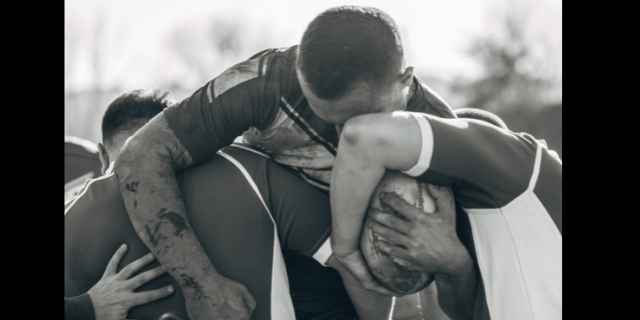Can you push in rugby in open play? Forget about scrums and mauls, can you give a good shove to an opponent rushing past you with the ball?
Youngsters playing rugby in the garden will push and shove each other with gusto. But you don’t see it very often in a match.
Does that mean it’s not allowed? Actually, no, it’s perfectly legal within limits.
Can You Push In Rugby?
Players can defend in rugby by pushing the opponent carrying the ball. However, it is far less effective than tackling or holding the ball carrier.
Players can also push in rucks, mauls, and scrums.
A limited form of pushing is permitted by the ball carrier when fending off a tackle.
Although one law in rugby permits pushing, there is another law that prohibits charging as a dangerous form of play.
This means that it’s up to the referee to interpret when a push becomes a charge. Referees tend to be far more strict at mini and youth level, and will actively discourage pushing. At adult level, it only becomes an issue when the “push” is judged to be a no-arms tackle. I’ll show an example in a later section.
What do the Laws Of Rugby say?

Here is the official answer to whether you can push in rugby: Law 7.1.
Any player may tackle, hold or push an opponent holding the ball.
World Rugby Laws
This may seem very cut and dried until you read Law 10.4.
Dangerous charging. A player must not charge or knock down an opponent carrying the ball without trying to grasp that player.
World Rugby Laws
If things aren’t perfectly clear, read on!
When Does A Push In Rugby Become A Charge?
The answer is when it’s a no-arms tackle. This short clip shows an example where the referee judged a strong push to be an infringement. As the infringement prevented a try, a penalty try was awarded.
What happened?
Wales traveled to South Africa in 2014 to take on the Springboks in Nelspruit (remember the name).
Wales was leading by six points on the 77th minute. The principality had never won in South Africa, so this would be a historic victory.
But the big Bok winger Cornal Hendricks was racing toward the corner with the ball. Two Welsh defenders were desperately covering across, but Hendricks lunged toward the line.
Welsh fullback Liam Williams went low and pushed the Springbok out of play. Sure, he didn’t push with his hands – but the Law that mentions pushing doesn’t mention that hands must be used to push.
Instead, the Welshman tucked one arm and used his shoulder to shove his opponent across the sideline.
What was the referee’s decision?
The referee watched a few slow-motion replays, but even the most staunch of Welsh supporters must have known the writing was on the wall.
The referee’s decision followed the law of charging: you can’t push or knock down a player without trying to “grasp” them.
Because Williams clearly didn’t try to wrap both arms around his opponent, this was judged to be a no-arms tackle.
Because the infringement prevented a clear try from being scored, the Springboks were awarded a penalty try. They kicked the conversion to overturn a losing score and won the match.
“Nightmare in Nelspruit” was the headline in a Welsh newspaper.
Why Is it Rare To See Players Being Pushed In Rugby?
A push is a very ineffective form of tackle, which is why you don’t see it very often.
The aim of tackling in rugby is to bring ball carriers to the ground where they must release the ball. This allows your teammates to compete to regain possession.
If you’re not holding your opponents when they hit the ground, the tackle may be considered to be “not completed”. The ball carrier doesn’t have to release the ball, and can jump up and keep running.
This is usually disastrous for the defense.
Even if a push knocks your opponent to the ground, you won’t have held them. Opponents are entitled to keep hold of the ball and try to evade further tackling.
Most Common Form Of Pushing In Open Play
When are you most likely to see a push in open play?
When the ball carrier is running flush with the sideline, and all it takes is a simple push to put them over the line and out of play.
This is usually a mental calculation of effort-reward. Of course, the defender can make a full-blooded tackle, hip to thigh, with both players hitting the deck out of play.
But you get the same result: the ball carrier has taken the ball over the line, and your team gets the line-out.
Is a full tackle worth the effort?
Yes, at the start of the match when you’re “laying down a marker”. Probably not, if you’re a prop wheezing in the 79th minute.
Be careful about hoardings or obstructions
Some pitches have advertising hoardings or other kinds of obstructions quite close to the sideline.
If you push your opponent who collides with an obstruction, the referee may take a dim view of your actions.
Dangerous play is a matter of judgment for the referee. Be sporting, and don’t put the decision for a penalty into the ref’s hands.
Remember, your opponent has coughed up possession by carrying the ball over the line. It’s a dumb move to cough up a penalty in this scenario.
Minis and youth rugby
Plenty of referees won’t tolerate any form of pushing at the minis level.
And at youth level, players are being encouraged to perfect their safe tackling technique. A push skips an opportunity for effective learning.
Pushing At Rucks, Mauls, And Scrums

This is a very different situation than pushing in open play. Rucks, mauls, and scrums are the only situations where you can push an opponent who isn’t holding the ball.
Of course, there are limits.
You can’t run up to a ruck or maul and push an opponent without doing so in a very specific way. The rules are different for both rucks and mauls, and I won’t go into them here. You can check out our article on rucking in rugby and our explanation of what a maul is in rugby.
But if you find yourself in a legitimate position in the middle of a maul, push with your heart’s content. And if you approach the ruck from a legitimate position, you can give an opponent a good shove.
And as for a scrum?
The hooker may be considered to be in possession of the ball. But the opposing props will push with gusto and hope that the forwards behind them are helping with that push.

Pushing With The Ball – Fends and Hand Offs
When you are the ball carrier, are you allowed to push an opponent who does not have the ball?
This type of push is known as a fend or a handoff. The ball carrier uses the palm of the other hand to push against the chest or face of a would-be tackler.
Times have changed!
Nowadays, you must be very careful about targeting the opponent’s face.
If the referee judges this to be a strike to the head, you will have committed a serious infringement. At worst you’ll receive a red card.
The safest option is to push out against the chest of your opponent with a stiff palm. That way you won’t be bringing the referee’s judgment into play.
Pushing An Opponent Without The Ball
What happens if you push an opponent who isn’t carrying the ball? Why on earth would you do so?
Well, let’s say that both of you are chasing after a kick and the ball goes over your try line. If your opponent racing beside you reaches the ball first, they will score a try.
And let’s say you’re a forward, and your opponent is a winger who is about to pull ahead of you. The question becomes: can you edge a little sideways with an ever-so-gentle nudge? You can try.
Take a look at what happens in this example of blocking in rugby by running interference. We’ve got a nice little video clip from a test match to illustrate what happens.
Now let’s take another scenario. You are chasing a ball that is heading toward the sideline. Your opponent is in front of you, blocking your path.
Can you deliver a good shove to get the player out of your way?
England captain Owen Farrell did just that to Scotland Captain Greig Laidlaw. We’ve got a clip and a description of what happens when a player blocks in rugby by shepherding the ball.
I’ll tell you here that the referee awarded a penalty kick. You may be surprised by which way he gave it.